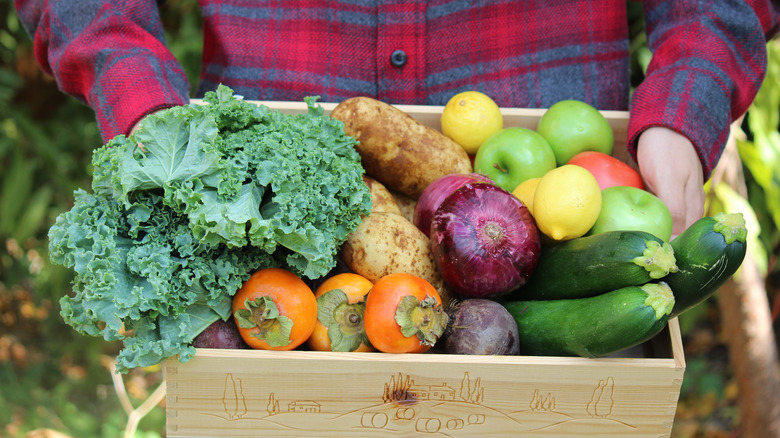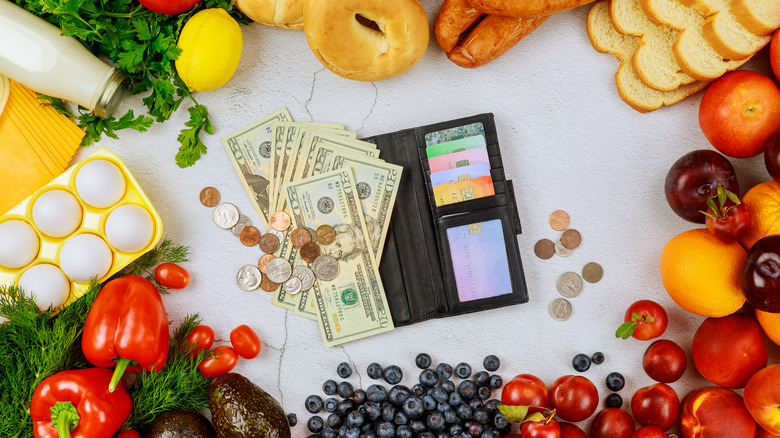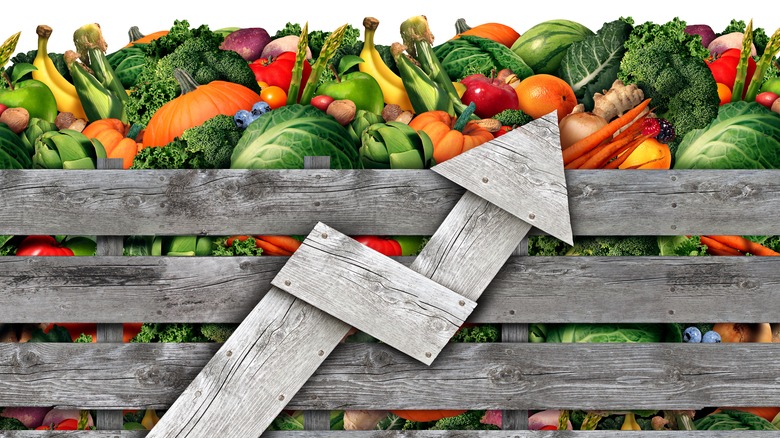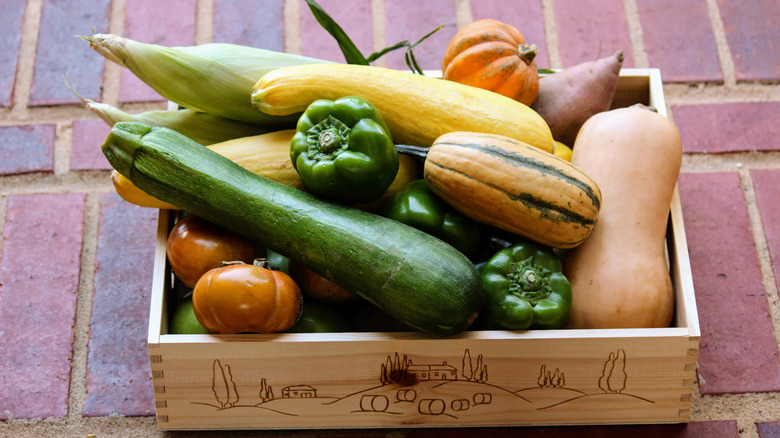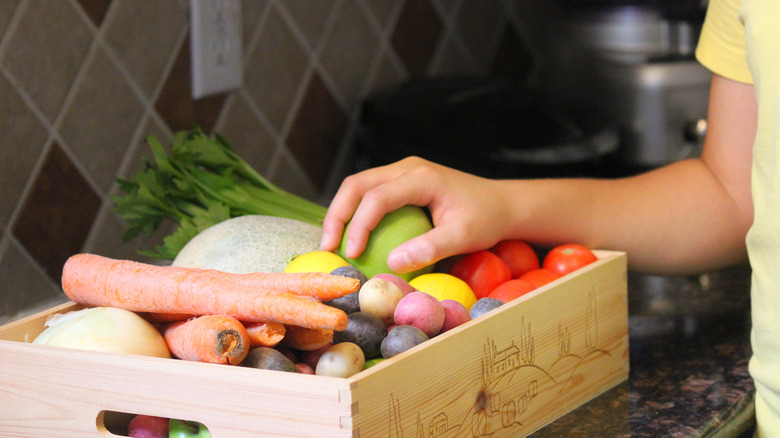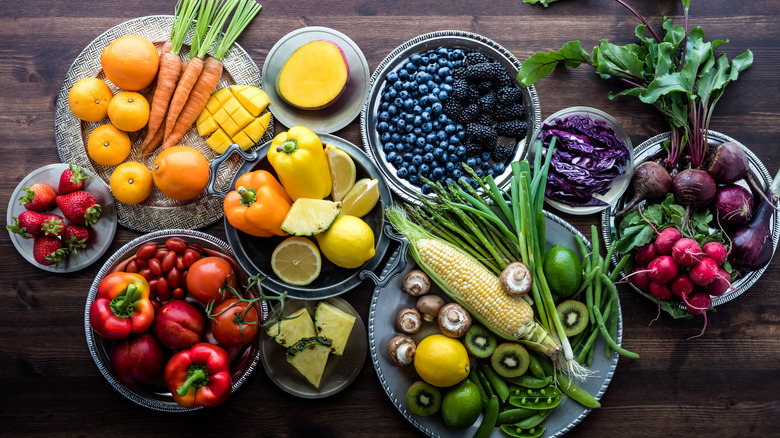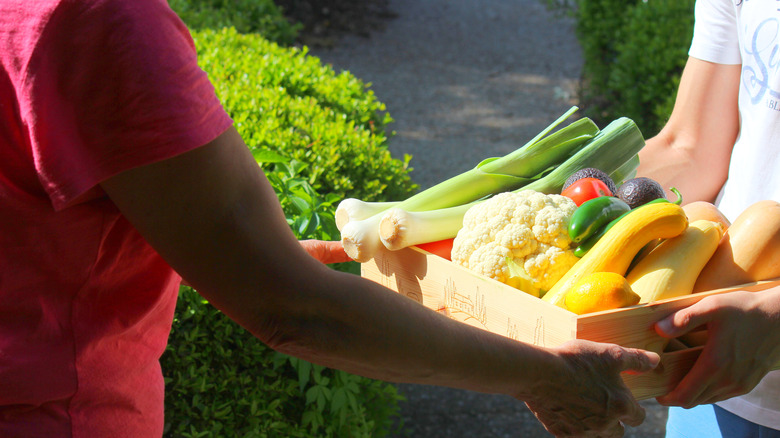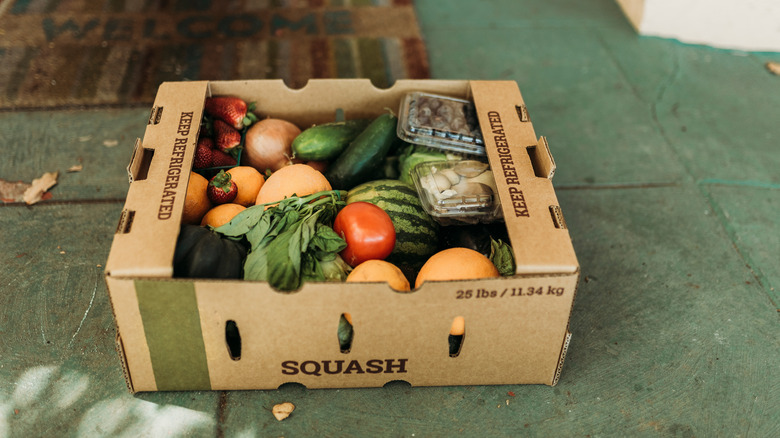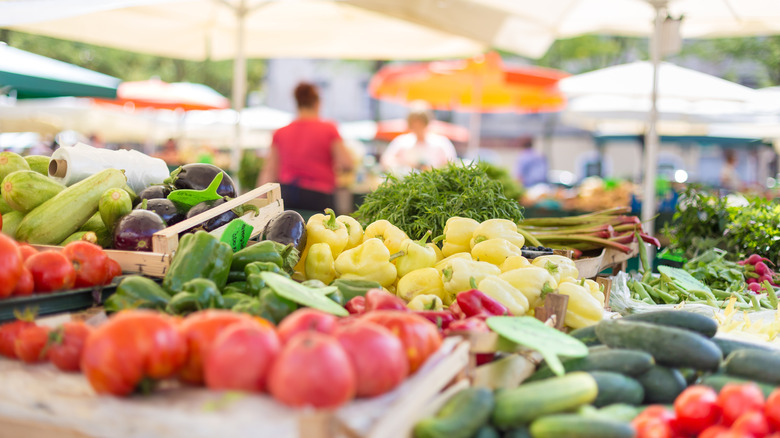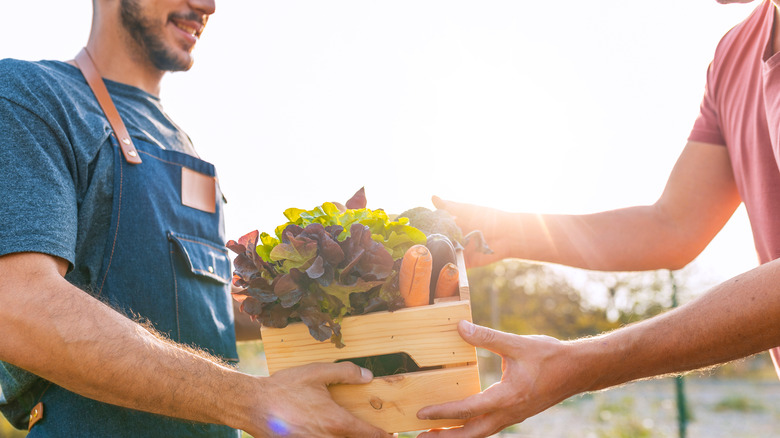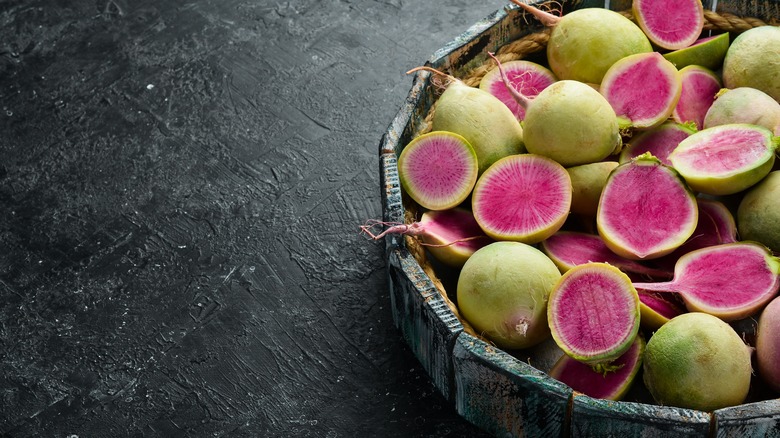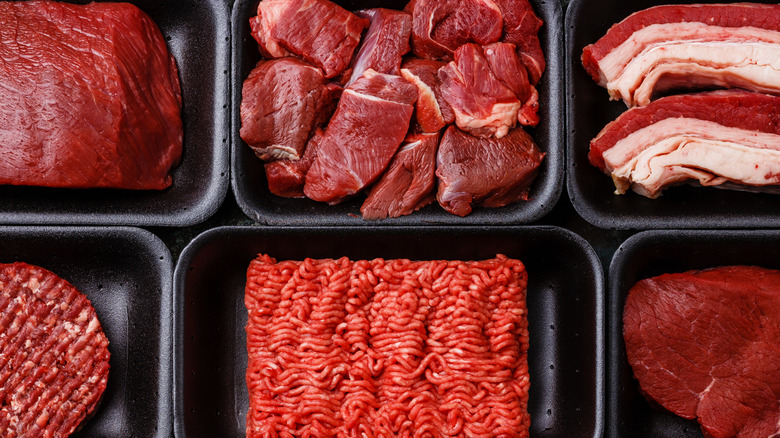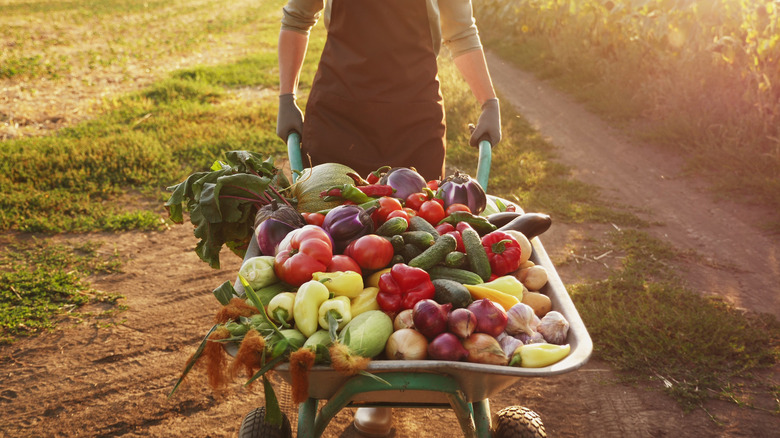Everything You Need To Know Before Signing Up For A CSA
Community-supported agriculture (CSA) is a popular way to engage with local food systems. If you happen to have missed out on this trend, CSAs are seen as a way for consumers to have a deeper connection with the farmers that produce their food. This distribution model, which was born in Japan in the 1960s, involves consumers purchasing a "share" (a season's worth of produce) from a local farm, which will be dispensed to members weekly. Massachusetts was home to the first CSA in the U.S. in 1984, and now there are over 2,500 programs in existence across the country.
You can find farms offering CSA shares in your area through Local Harvest, but before you start your research, there are some things you should know. CSAs are not for everyone, and it is not as simple as going to the grocery store to buy produce. We are here to help you decide whether a CSA is right for you and let you know what factors to consider when choosing a CSA.
It can be cheaper than the grocery store
Let's start with a benefit of CSAs. If you look at the total value of your share across the season, your allocated produce may result in savings on your food costs. Prices for CSA shares will vary based on your location, but you can generally expect memberships to fall between $400 and $700.
If you want to save money, you'll have to compare the weekly share cost to your typical vegetable consumption to see what's the least expensive option. In a direct comparison, Bring Me the News found one box in a Minnesota share to be cheaper than comparable produce at all but two local grocery stores (Whole Foods and Fresh Thyme), where many of the chains didn't even have as many organic options as the farm share.
You might suspect that CSA shares are cheaper than the grocery store because you are shortening the supply chain. When you don't buy directly from farms, there are additional parties that need to make money before the food lands in your shopping cart. This might be a contributing factor, but Don't Waste the Crumbs suggests that farms discount CSA memberships in exchange for advanced payment. By pre-paying for the season, they calculate that shareholders could save about $44 per month compared to buying those same vegetables at the producer's farm stand.
You pay the cost upfront
We've established that a CSA membership has the potential to save you money on groceries, but there is a downside. If you are thinking of signing up for a CSA, one important thing to keep in mind is that many farms require you to pay upfront for the entire cost of the share, making those savings more of a long-game benefit. With some shares costing as much as $1000 a year, that is a big financial commitment.
The nature of this distribution model is that the upfront payments provide security to farmers for the growing season. If money is tight, you might feel like you can't afford to purchase a share. However, some farms offer flexible options, such as weekly or monthly payments. Others may require you to pay for 50% of the share when you sign up, with the remainder due at a later date, allowing you more time to gather funds. SNAP recipients can now also use their benefits to pay for shares, but farms do need to be approved as SNAP vendors and ensure that they follow all the rules set by the USDA.
There are different size shares
One of the most important questions to ask yourself whenever you are considering joining a CSA is which size share is right for you. Choosing the wrong size could leave you needing more supermarket runs or unnecessarily throwing out food.
Most farms will offer at least two options, a small and a large share. Small shares are generally recommended for households of 1-2 people, while the larger size may be better for families with 3-4 people. Individuals and couples would benefit most from the small boxes, or perhaps families looking to casually introduce more local produce into their diet. The large shares would be ideal for families with multiple children, but it doesn't have to be limited to single households. If you pair up with a few friends and split the cost, a large box could be an economical way to get fresh, organic produce every week. Plus, you can switch off weeks for pickups.
You should also think about what mix of produce you'd like to receive. The most common option is a vegetable share that offers the occasional fruit, but you may find offerings in your area for a more even split or even just fruit if that's what you like.
It's a commitment
When you sign up for a CSA share, you are buying into an entire season of vegetables. A farm may describe memberships as the summer share or winter share, but some may run even longer than a single season. You can find many shares that begin around the beginning of summer and then run through early fall. Oftentimes, you can choose to extend your membership through the late fall season, allowing you to take advantage of all the autumn produce. You might even get a nice pumpkin to bake for Thanksgiving.
A great point of advice is to pay close attention to the length of CSA seasons, noting that they might last up to 25 weeks (about 6 months). In some cases, memberships may run indefinitely and will automatically renew for the next season unless you cancel. CSA memberships are quite a commitment. When you purchase a 20-week share, that is a long time to go to a designated place to collect your produce. That's also 20 weeks of meal planning around a box of vegetables with no break. There is no living off takeout on a week when you're feeling burnt out. However, if you do need a little push to get yourself to cook more, a guaranteed supply of produce that you already paid for can be enough of an incentive to make sure the food doesn't go to waste.
It can be a lot of produce
On top of the time commitment, CSA shares can provide a shocking amount of food. Even if you already cook a lot, the small share might be more produce than you can eat in a week by yourself. You should plan for there to be weeks where you have to get creative with meal planning. A bit of great advice is to cook recipes that will use a lot of produce, such as smoothies, soups, and salads. Other ideas include stir-fry and curry dishes. You may even want to prep and freeze vegetables for future use.
If you are partaking in a fruit share, making homemade jam is a great way to use up fresh berries, which tend to go bad quickly. How many times have you brought home some beautiful cartons of berries only for mold to appear before you start eating them?
Another way to make the most of your produce is to ensure a longer shelf life. By storing vegetables correctly, you can limit your food waste. Don't store onions with your potatoes, as alliums can cause your spuds to sprout prematurely. Leafy greens, as another example, will last the longest if you wash them as soon as you bring them home. Wrap cleaned greens in paper towels and store them in sealed containers or plastic bags to keep them crisp.
Pickup options might not be flexible
You might get lucky and find a CSA membership with a ton of flexibility, but that is not the case for most. Many CSA shares have strict rules for pickups. If you read the FAQs on various farm websites, they will likely suggest you send a friend to pick up your box if you can't make it a particular week. Some farms, like Clark Farm in Massachusetts, may also give the option to donate your weekly share to a local meal center, but they won't allow you to pick up on a different day.
When choosing a CSA, do some research on pickup days and times. Farms don't always have the resources to offer a wide variety of locations and pickup windows, so make sure to select one that fits your life. If you have an unpredictable schedule, a flex share may be best for you. In a flex model, consumers purchase a set number of weeks for the season and can pick up on whichever weeks they choose. This gives customers an option for customization without farms having to work so hard to keep track of part-time shares or special requests.
You won't always know what you're going to get
When you sign up for a CSA share, you have to prepare yourself to come up with meal ideas on the fly, as each week will provide different items. Your box dictates what you are going to cook each week, and if you rely heavily on recipes to cook, keep in mind that you'll have to wait and choose recipes until you know what will be in your next box.
Farms typically send a weekly newsletter detailing what they are currently harvesting, but it might come only a couple of days before pickup. We've also found that farms might err on the side of more general descriptions to avoid giving shareholders false expectations. A farm might be harvesting four types of squash and list "squash" in the weekly harvest email instead of specifying delicata, acorn, or butternut. That way, they won't need to rely on just one variety to fill all the shares. In that case, you may not know exactly what is coming your way until you open the box.
If you have picky eaters in your family, see if you can find a farm with a pick-your-own model. The CSA at Verrill Farm in Massachusetts allows members to select what will be in their box each week with a pickup experience that resembles shopping at a farmers market.
There might be volunteer requirements
One little-known aspect of CSA memberships is that farms may require shareholders to participate in volunteer activities on the farm or at distribution centers. Roxbury Farm in New York asks their CSA members to volunteer at pickup sites for 3 to 4 hours per season and rely on these volunteers to distribute the produce each week. While this is not a stipulation of all CSAs, you should know the expectations of the CSA you plan to sign up for before making your selection. If you want to avoid dealing with volunteer work, find a membership without that requirement.
Volunteering can also be a way to make CSAs more accessible. Not everyone can spare hundreds of dollars for vegetables, regardless of whether it's for a CSA share or at the supermarket. Farms might offer a partial or full discount on memberships in exchange for completing weekly volunteer hours at the farm.
You get to support a local farm
When you shop at the grocery store, you rarely get to know much about the produce you are buying, aside from the country or state of origin. One benefit of CSAs is that they reconnect consumers to the land. There are some cooperative-style CSAs that gather produce from multiple locations, but in general, you are choosing to invest in a specific farm. You can shop around before deciding, and you may even consider factors other than cost and pickup schedule. If desired, you can choose a farm that fits certain criteria, such as being woman-owned, but maybe you'll find a farm with a story that just appeals to you more than others.
CSAs give consumers the opportunity to understand not only where their produce is grown but also who is growing it. Those weekly newsletters can make you feel more connected to your farmers and your food. Another upside of CSAs is knowing that your investment helps provide the funds for farmers to buy seeds and equipment they need for the growing season. You don't get to feel that same impact when shopping at the supermarket.
You get to try new produce
The standard CSA model does not offer members a choice as to what appears in their weekly box. If that doesn't sound appealing, then maybe shopping at the farmers market is a better choice for you. However, a CSA membership could be a good opportunity to challenge yourself to be a more adventurous eater. Try to keep an open mind and flexible taste buds. You might even discover you like a certain vegetable more than you originally thought.
CSAs also offer the chance to try unique vegetable varieties that aren't readily available in supermarkets. For instance, Rustic Road Farm in Illinois offers specialty produce like watermelon radishes, Hakurai turnips, and Prudence Purple tomatoes. Even if these items are available at grocery chains, you may have passed on them in the past because they were more expensive than your typical garden variety vegetables. Throughout the season, you're likely to see the entire color spectrum represented, which will give you some picture-perfect meals.
You can get more than just fruits and vegetables
Farm shares are a great way to get freshly-picked local produce, but it turns out CSAs aren't just for fruits and vegetables. A whole assortment of food companies now offers CSA-style services, from wineries to creameries. Like regular CSAs, these memberships help connect consumers with food producers and procurers, making your meals feel a little less anonymous.
If you live in New England, you can sign up for a meat share from Walden Local Meat where you'll get a curated mix of meats each month along with information about where the animals were raised. Perhaps you don't eat much meat but love seafood. Mermaid's Garden in Brooklyn provides a seafood share where members get weekly bundles of filleted fish. Another unique offering comes from Farm Feast in Massachusetts. This is a grain share with an annual distribution. The half shares come with 30-40 pounds of heritage grains and corn as well as heirloom beans and wheat, while the whole share gets you 60-80 pounds. You will need room to store a year's supply of grains, and it's also ideal if you have the equipment and time to mill your own flour.
Shares sell out fast
If you want to get in on the summer CSA season this year, you might think you still have plenty of time to sign up for a share, but that may not be the case. At the end of the fall harvest, many farms are already selling shares for the following summer. According to a report from Weston Owl, by March of last year, a number of the summer CSA shares in the Boston Metropolitan Area had already been sold out, with many others selling quickly. If you want in on the action, aim to purchase your membership as early as you can.
Farms choose a specific amount of shares to offer each season based on conditions like land and labor. University of Wisconsin-Madison suggests that farms shouldn't provide more than 30 shares per acre of farmland. Because resources are limited, overselling shares could mean major trouble for farms filling the boxes each week. Once farms sell out of the allotted shares, they are unlikely to add more. The longer you wait to sign up, your options will dwindle until none are left.
You share the risk with farmers
CSAs certainly have a lot of benefits, but it's not without uncertainty. This model works because both parties (farmers and community members) share the risk of the growing season. Similarly to traditional shareholders, as a CSA member, you are assuming a part of the business's risk, and farming is not the most predictable industry.
With the upfront payments, CSAs help ensures that farmers get some income regardless of that season's harvest without having to take on high-risk loans. What this means for you is that when a farm has a tough growing season, your share may contain less produce than you anticipated. You might really be looking forward to summer tomatoes, but if it's a low crop year for that item, you probably won't get as much as you want. This is all part of the wager of CSA memberships. You're essentially a temporary investor in the farm. It's certainly a gamble, but if you're lucky, you'll get to enjoy a bountiful harvest.
